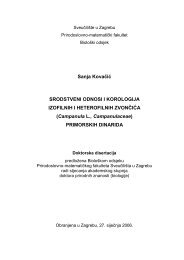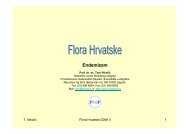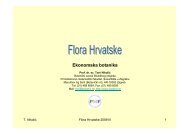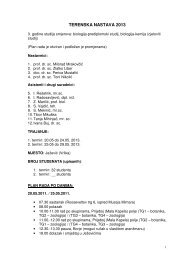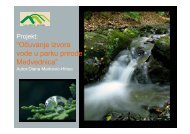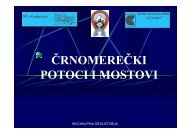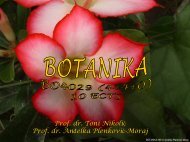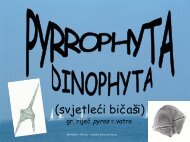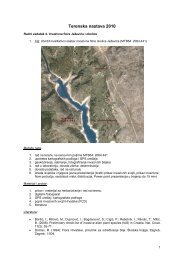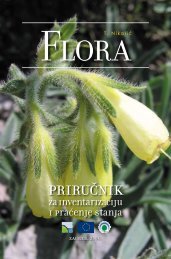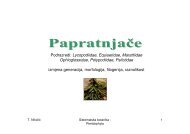Section 6ReferencesBirdlife International, CEE Bankwatch,Friends of the Earth Europe,Transport & Environment,WWF, 2003Conflict Areas between theTEN-T <strong>and</strong> Nature Conservation: CaseStudies, July 2003.Transport & Environment,WWF-European Policy Office, BirdlifeInternational, CEE Bankwatch, 2002, Trans-European Transport Networks: Options for aSusta<strong>in</strong>able Future. T & E 03/2.Development: transport, <strong>in</strong>frastructure <strong>and</strong> tourismTransportThe CEE region is undergo<strong>in</strong>g rapid economic change <strong>and</strong> part of that transition<strong>in</strong>volves the development of the Trans-European Transport Network (TEN-T), which setsout plans for the development of road, rail, air <strong>and</strong> waterways. However theestablishment of this transport network directly t<strong>hr</strong>eatens several <strong>important</strong> sitesidentified under the EU Natura 2000 network.A recent report by environmental NGOshighlights the lack of environmental impact assessments <strong>in</strong> the creation of the TEN-Tnetwork <strong>and</strong> the contradictions with the aims of the EU Nature Conservation policies.The report recommends that no EU funds are allocated for transport projects thatt<strong>hr</strong>eaten EU Natura 2000 sites <strong>and</strong> that all TEN-T projects undergo thoroughEnvironmental Impact Assessments. New data from this IPA project on priority sites for<strong>plant</strong> conservation should also be used <strong>in</strong> environmental impact assessments of TEN-Tprojects.127 IPAs (16%) record transport <strong>and</strong> <strong>in</strong>frastructure development as a direct t<strong>hr</strong>eat.Development <strong>and</strong> tourismUrban <strong>and</strong> <strong>in</strong>dustrial development <strong>in</strong> the CEE region is also <strong>in</strong> a period of rapid change<strong>and</strong> potentially t<strong>hr</strong>eatens many valuable <strong>plant</strong> sites. However, recreation <strong>and</strong> tourismdevelopment are recorded as the most common t<strong>hr</strong>eats to IPAs.302 IPAs (38%) are t<strong>hr</strong>eatened by tourism <strong>and</strong> recreation developmentThe t<strong>hr</strong>eat comes not only from the build<strong>in</strong>g of tourist accommodation or facilities butalso from exceed<strong>in</strong>g capacity on protected <strong>areas</strong> <strong>and</strong> nature trails.Tourism, especiallyeco-tourism, has the potential to be a powerful tool <strong>in</strong> awareness rais<strong>in</strong>g <strong>and</strong> fund<strong>in</strong>g ofconservation work but needs to be developed with local l<strong>and</strong> managers <strong>and</strong> specialiststo ensure that rapid development does not destroy the high nature value of these sites.NEJC JOGAN16% of IPAs are t<strong>hr</strong>eatened bydevelopment of transport <strong>and</strong><strong>in</strong>frastructure86
Habitats <strong>and</strong> l<strong>and</strong> usesSusta<strong>in</strong>able <strong>plant</strong> useThe ma<strong>in</strong> uses of wild <strong>plant</strong>s <strong>and</strong> fungi <strong>in</strong> Europe are herbal medic<strong>in</strong>es, decorative <strong>plant</strong>s,berries <strong>and</strong> mus<strong>hr</strong>ooms for food, forestry products, timber, <strong>and</strong> peat for horticulture.The scale of collection of these wild <strong>plant</strong> products ranges from small amounts forhousehold use <strong>and</strong> local markets to large scale collection for <strong>in</strong>ternational corporations.Medic<strong>in</strong>al <strong>plant</strong> collection for household <strong>and</strong> market economies is most widespread <strong>in</strong>south <strong>eastern</strong> Europe. In many cases the use of wild <strong>plant</strong>s is of positive benefit to localeconomies <strong>and</strong> biodiversity but there are risks of over-exploitation <strong>and</strong> susta<strong>in</strong>ablecollection practices need to be established.The extraction of peat for horticulture is stilla widespread practice. However as legislation <strong>in</strong> EU countries tightens there is a dangerthat peat exploitation will move beyond the boundaries of the EU.IPAs <strong>and</strong> wild <strong>plant</strong> useWild <strong>plant</strong> gather<strong>in</strong>g is recorded as a l<strong>and</strong> use on 103 IPAs (13%)Unsusta<strong>in</strong>able <strong>plant</strong> gather<strong>in</strong>g is recorded as a t<strong>hr</strong>eat at 81 IPAs (10%), although this isma<strong>in</strong>ly assessed as a low level t<strong>hr</strong>eat.Peat extraction is recorded as a t<strong>hr</strong>eat at 31 IPAs (4%)Protection of wild <strong>plant</strong>s from unsusta<strong>in</strong>able collectionMany of these <strong>plant</strong>s, especially decorative flowers, berries, mus<strong>hr</strong>ooms <strong>and</strong> somemedic<strong>in</strong>al <strong>plant</strong>s, are perceived to be common, however this makes them morevulnerable to over-exploitation.There are several legal provisions for the protection ofwild <strong>plant</strong>s. CITES, the Convention on International Trade <strong>in</strong> Endangered Speciesprohibits the collection <strong>and</strong> sale of many <strong>plant</strong> species.Annex V of the EU HabitatsDirective obliges EU member governments to safeguard resources of many <strong>plant</strong>species. Many national governments also have wildlife protection legislation, e.g. <strong>in</strong>Bulgaria, where particular species are legally protected <strong>and</strong> specific sites have annualcollection quotas.ReferencesAnnex V of the EU Habitats Directives,1992, Animal <strong>and</strong> Plant Species ofCommunity Interest whose tak<strong>in</strong>g <strong>in</strong> the wild<strong>and</strong> exploitation may be subject tomanagement measures.(www.europa.eu.<strong>in</strong>t)Convention on International Trade <strong>in</strong>Endangered Species (CITES) website(www.cites.org)Kathe W., Honnef S., & Heym A., 2003Medic<strong>in</strong>al <strong>and</strong> Aromatic Plants <strong>in</strong>Albania, Bosnia-Herzegov<strong>in</strong>a, Bulgaria, Croatia<strong>and</strong> Romania. WWFDeutschl<strong>and</strong> <strong>and</strong> TRAFFIC Europe-Germany (www.bfn.de)TRAFFIC website (www.traffic.org)V<strong>in</strong>es, G., 2003 Herbal Harvests with aFuture:Towards susta<strong>in</strong>able sources formedic<strong>in</strong>al <strong>plant</strong>s. Plantlife InternationalOrganisations such as TRAFFIC trace the route of medic<strong>in</strong>al <strong>plant</strong>s from collectors tothe herbal medic<strong>in</strong>e market <strong>and</strong> work to establish susta<strong>in</strong>able collection strategies.Information on peat free grow<strong>in</strong>g media is available from several sources <strong>in</strong>clud<strong>in</strong>gorganisations such as the Royal Horticultural Society.NEJC JOGANLocal women collect<strong>in</strong>g wild <strong>plant</strong>s <strong>in</strong>Slovenia.87



